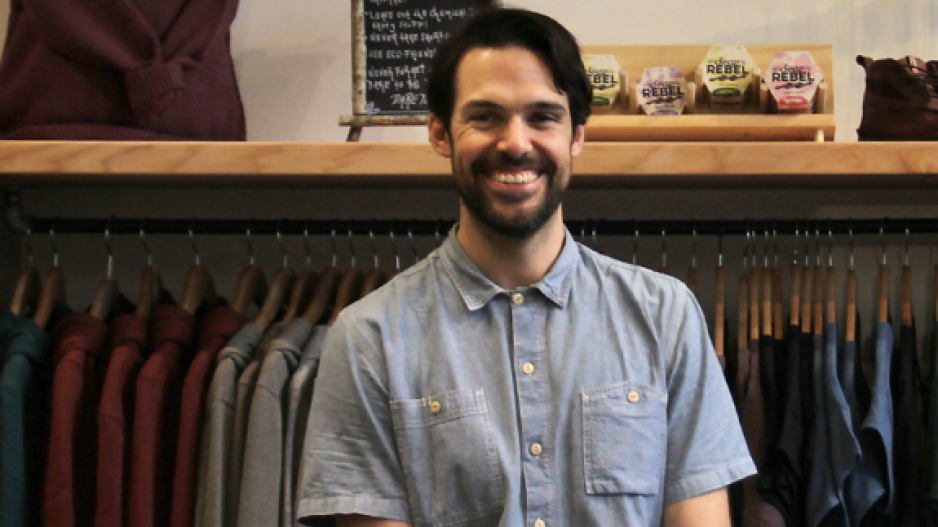Like many West coast companies, Victoria-based Sitka wants to embrace – and market – an environmentally sustainable, buy-local ethos.
The clothing maker has embedded sustainability goals in its corporate culture and has a plan to donate 1% of its profits to nature conservation projects.
The 38-employee company is also in the process of pulling all manufacturing out of China and back to North America.
“We were predominantly overseas, mainly in China [two years ago],” Gauthier said. “We made the decision that we were going to commit to producing things as close to home as possible.”
At this point, Gauthier said, the company produces 60% of its products in north America through various contractors and plans to make everything in either canada or the United states by 2016.
It’s a move that will come with conse- quences for the small company, which has three retail locations of its own andsells clothing and “West Coast” lifestyle products such as surf- boards, fishing gear and even axes in around 100 stores across North America.
“In some cases, products that we’ve made in the past, you can’t currently get them made here,” Gauthier said. That means the company will discontinue those products until it can find a North American manufacturer.
“On some of our goods the price will go up – that’s just how it is – but perhaps over time that will change.”
Changing the way the company operates has not been without challenges: in January, Sitka laid off 10 employees. It has since been able to hire five of those people back, and Gauthier said the company is currently in good financial shape. A crowdfunding campaign to support the business’ new vision had raised $8,000 at press time.
Sitka is moving its manufacturing back to Canada because it fits with the company’s sustainability goals and because the company wants to support local manufacturing, Gauthier said. But there are some logistical upsides to make things closer to home.

Sitka’s “West Coast” products include outdoor gear and recreation accessories | Robyn Penn/Maui Maka Photography
“You don’t have to put something on a boat for 30 days – that’s a huge benefit,” Gauthier said. “You can put it on a train or a truck and it can be there in four days."
As China’s economy has matured, labour costs have risen. That’s put North American apparel makers on more of an even footing with China, said Bob Kirke, executive director of the Canadian Apparel Federation.
Those changing costs are making local manufacturing more appealing, especially for smaller companies like Sitka.
“China was great for a long time; it still is very good for decent- sized companies, but it becomes very difficult for smaller firms because Chinese firms want bigger orders,” Kirke said.
Meanwhile, countries with relatively cheap labour, like Cambodia or Bangledesh, can’t offer the same level of quality, he said.
For companies looking at making the switch, the challenge is that North American clothing production has been hurt badly by the move to manufacture overseas. In 2000, there were 100,000 workers employed by garment makers across Canada. Kirke estimated that around 70,000 jobs have been lost over the past 15 years, with the current number of workers between 20,000 and 30,000.
Many of the workers who are left are near retirement age. There are fewer younger workers available to take jobs, which tend to be low wage but require a high level of sewing skills.
Companies that decide to stay in Canada or move manufacturing to this country need to doa good job of selling that story, Kirke said.
“[Consumers] like the idea of buying a Canadian-made product in a way that has not really been, even at a sort of notional level, part of the makeup of Canadians for a long time,” he said.
But that doesn’t necessarily mean they’ll pay more for a locally made product. Companies normally have to make up the higher manufacturing costs in higher-priced products. Arc’teryx and Canada Goose are examples of that: Arc’teryx manufactures its priciest products in its Burnaby facility, while Canada Goose jackets are priced at upwards of $800.
Competing with the likes of Walmart (NYSE:WMT) isn’t impossible, however. C&O Apparel, which employs 300 people in Vancouver, makes yoga clothing for Costco (Nasdaq:COST) priced at around $20 for a pair of yoga pants.
“They’ve got it down. They’re only running a few products; they’re doing it very efficiently,” Kirke said. “And Costco likes that it says ‘made in Canada’ on that product.”
Even Walmart, with its “lowest price guarantee,” is doing more of its manufacturing in the United States, Gauthier said.
“It’s not why we’re doing it, but there are some big players that are betting that making products domestically will become a lot more reasonable here in the future.”
@jenstden




